Old School Magic is a phenomenon that has swept the globe in the last few years, establishing new pockets of players committed to the idea of a more social and yet nostalgic gaming experience. Old School Magic provides an environment with cards that have greater aesthetic appeal, and a more social, less anxious player base. Although sometimes mistaken as such, Old School is not a single format, such as 93/94, but a virtually infinite range of formats. Among them, one niche that has rapidly expanded in the last year, despite being (probably) the most expensive and cost prohibitive, is known by the moniker “Alpha Card 40,” or simply “Alpha 40.” As a sign of the growth of the format, the Alpha Card 40 Facebook group grew from 40 people to over 700 in less than year.
Alpha 40 is also known as First Edition Magic, or Limited Edition Magic, since Alpha was technically marketed as such, and was subsequently known as “First Edition.” Regardless of the nomenclature, the idea is to play Magic as it was experienced when it was first released at GenCon way back in August, 1993. As such, the format uses the First Edition rule book (which is not nearly as daunting or complicated as you might imagine), and has no floor rules outside of that slim rule book. That means that the format requires ante (or, in practice, a ‘fake’ ante), no mulligans, and no sideboards. But it also means that you play 40 card decks with no other restrictions, such as a Banned and Restricted List, let alone 4-of card limits. The main limitation is access to cards, and the cost of acquiring them. In practice, this has a tremendous salutary effect in curbing the more broken possibilities. Usually.
In this article, I recount my year-long journal exploring this format, describe my hunt to acquire cards and assemble and field a tournament weapon, and then describe my unforgettable and historically significant experience competing in a major Alpha 40 tournament, dubbed “The Wizards Tournament II.” Organized by Magnus De Laval, the organizer of “n00bcon,” the “Old School World Championship,” the Wizards Tournament was a side event held in 2018, and received far more interest and players than initially imagined. Magnus decided to run the event again this year, and got 102 players to come to the Rotary Pub in Gothenburg, Sweden on the day before n00bcon to play Alpha 40. I was among them.
As an old school Type I player, I long harbored an Alpha prejudice, favoring Beta. This was largely because Beta was legal whereas Alpha was not for some time. Moreover, Beta’s less rounded corners had a more sober feel and appearance. Somewhere in the early 2000s, however, I began to appreciate the appearance of Alpha. I remember somewhere around 2003 watching Carl Winter play with his Alpha-Powered Type I decks and remarking how “cartoony” his Power 9 seemed. The more rounded corners create a light-hearted and more bubbly and buoyant aesthetic.
I am now firmly in the camp that prefers Alpha over Beta, and not simply because it is three times as rare and far more expensive. I simply prefer the appearance of Alpha cards, finding them gorgeous all over. The border, somehow, seems to accentuate the interior art even more, making the colors and images pop out of the frame.
Strategic Possibilities in Alpha
Diving into Alpha 40 is as fun as it might seem. The set is gorgeous to peruse, and the absence of 4-card restrictions means that the format is more freewheeling than regular single-set constructed. That Plague Rat deck can be all Plague Rats and Swamps, if you want. I began my investigation into this tantalizing format by cataloguing routes to victory.
There are basically three ways to win games in Alpha 40: 1) decking your opponent, 2) inflicting lethal damage via creature attack, or 3) direct damage. Despite the limited card pool, there are a surprising range of options for each strategic approach, and some subtleties besides. They are worth reviewing with more than a superficial level of detail.
Decking
In a constructed format where the minimum deck size is 40 cards, decking your opponent is a more attractive option than is usually the case, when they have a larger deck. Unfortunately, there are precious few tools to accomplish this objective. The most famous decking mechanism in Magic’s early game is Millstone, but this precious artifact was not available until Antiquities, although it was swiftly reprinted in Revised Edition a few months later. That leaves three main options. The first involves casting a large, and lethal Braingeyser. There are many difficulties involved in this option, not the least of which is that it is very mana intensive, and a very pricey card besides.
The second option is a bit more subtle: Wheel of Fortune(s). If both players would deck simultaneously, the game is a draw. But if you have a slightly larger library than your opponent – say, by building a 43 card library, then you can cast Wheel of Fortune to deck your opponent but not yourself. Thus, a multiple-Wheel deck of larger than average size could theoretically cast multiple Wheels in the space of a few turns to try to deck an opponent. You don’t need 20 Wheel of Fortunes to make this work. Less than a half dozen can do, provided you have enough defense to survive the game in the meantime. This option is an attractive choice, but also expensive to build, and runs the risk of outright losing before the game has begun to a suboptimal but oversized deck – not a rare occurrence in this strange and wonderful format.
The third option is just to build a slightly larger deck, and try to erect a castle defense that an opponent cannot penetrate, with firm knowledge that your opponent will deck themselves. This option may be viable, but is hardly enticing.
For completeness stake, I should note that it possible to win with Ancestral Recalls, but to deck the opponent you need to cast about 11 Ancestral Recalls without allowing the opponent to be able to take advantage of the card advantage. Not easy.
Creature Attack
The second strategic possibility within the card pool is mounting a creature attack that can inflict lethal damage. This is the usual way that games of Magic are won, and it is certainly a viable option within the domain of Alpha 40. Although the creatures range wildly in power level, each color provides roughly 8 to 19 creatures that can be used on offense, with artifacts supplying another half dozen. Red has the deepest pool of creatures, with white and blue offering the fewest. Nonetheless, each color offers more than enough to fill a deck, especially with no card restrictions other than dollar cost and availability. I will review these options in more detail below.
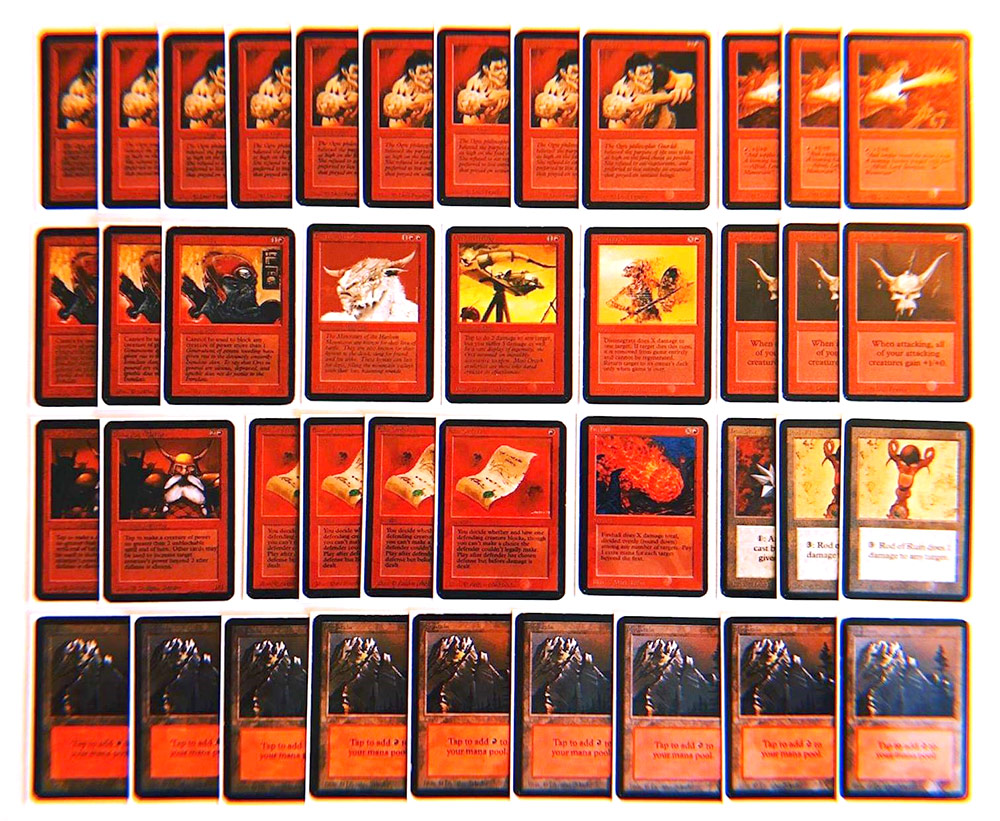
Direct Damage
Despite its early provenance, Alpha contains a surprising number of cards that deal damage directly, without requiring a creature attack. The most obvious cards that do this are the suite of red “burn” spells, such as Fireball, Disintegrate, Lightning Bolt, and Earthquake, but there are others in blue such as Psionic Blast and Volcanic Eruption. This hardly exhausts the range of direct damage possibilities.
In fact, the closer you look into Alpha, the more sources you find.
To begin, there is a class of cards colloquially known as “curses,” which includes Cursed Land, Wanderlust, Feedback, and Warp Artifact, each of which inflict direct damage. Copper Tablet generates a similar effect. More broadly, there are cards that create conditional damage, such as Psychic Venom, Ankh of Mishra, Manabarbs, Psychic Purge, Dingus Egg, and Black Vise. Then, there are activated sources of damage such as Pestilence, Prodigal Sorcerer and Rod of Ruin.
One of my favorite direct damage decks I’ve come across is an Orcish Artillery deck with Circle of Protection: Red to protect the controller from self-inflicted damage. That’s even more interesting than trying to combo Icy Manipulator with Psychic Venom!
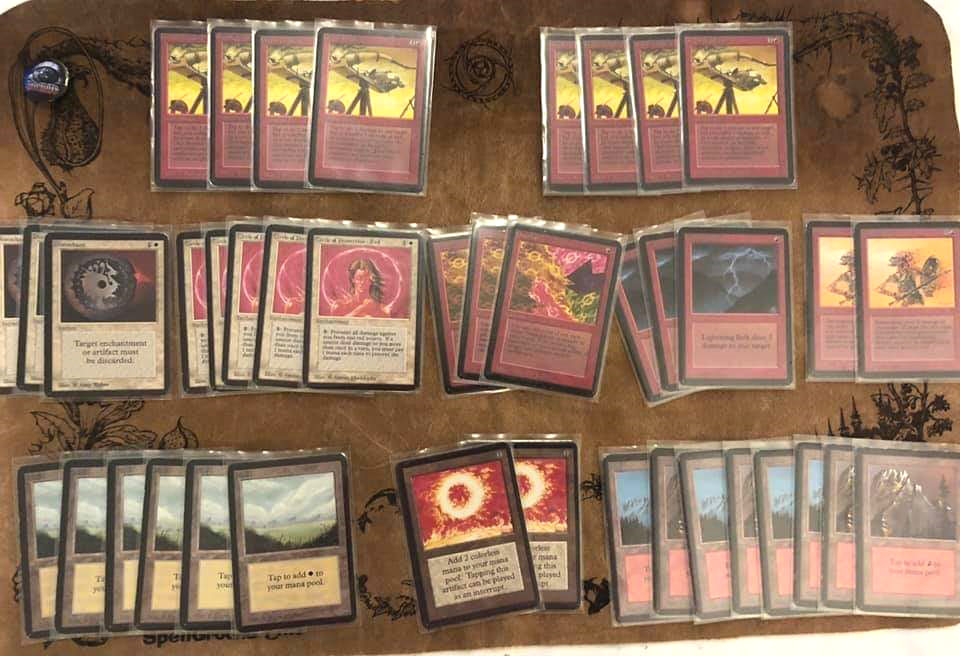
Direct damage is a remarkably promising strategic option depending on what you can build around it. The conditional sources of damage are weak, but the cumulative effect can be powerful. But more than that, trying to win the game through such routes can be enormous fun. Direct damage is certainly a viable route to victory, and there are faster and more circuitous, but more memorable, ways to get there.
Metagame Poles
One of the interesting things about a format without 4-of card restrictions is that a constructed deck can be made up entirely of two or three unique cards: lands, and 20+ copies of a single card. In the 1993 chapter of my History of Vintage project, we saw this with Rudy Edward’s “Wild Era” Magic deck, which is just Taiga, Kird Apes, and Lightning Bolts.
Alpha 40 reintroduces this compressed form of deck building canvas. My two favorite versions that have appeared in duels and tournaments are the Benalish Hero deck and the Plague Rat deck.
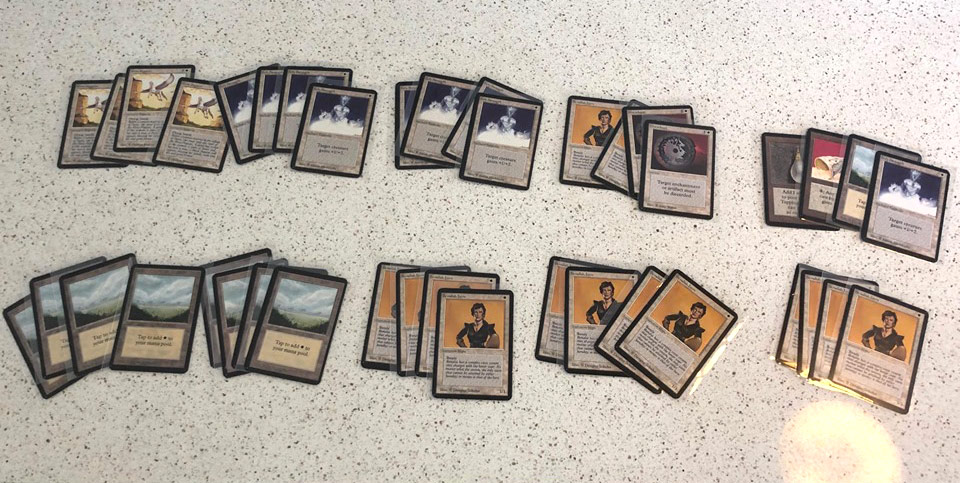
The Benalish Hero deck is surprisingly resilient and robust. For the more streamlined versions, the play pattern is: Turn 1: Hero, Turn 2: double Hero, and Turn 3: triple Hero, with another hero arriving more than every other turn. As long as the deck churns out Heroes at that clip, it’s a very difficult deck to overcome on the ground. Juggernauts, for example, trade basically one-for-one against a band of Benalish Heroes. It’s not a good trade for the Juggernaut controller. That’s why the Scryb Sprite deck, while being superior in terms of evasion, is actually less effective in combat. A squadron of Sprites are felled in combat with Juggernaut. The band of Heroes survives, save one.
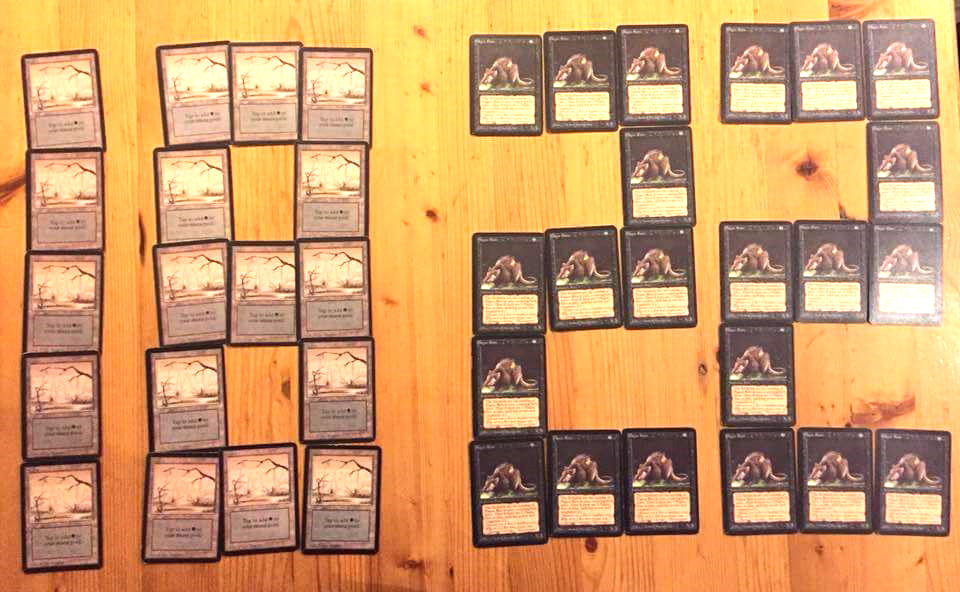
Equally impressive, if not more so, is the Plague Rat deck. This deck comes in two forms: 1) playing it straight as simply Swamps and Rats, or 2) adding some acceleration into the mix, such as Dark Rituals. Having seen both in action, I prefer the latter. The deck basically plays one Plague Rat per turn for the first four or five turns, and then plays another nearly every other turn for the rest of the game. In short time, the Rats are too big to be easily dealt with by Lightning Bolt, and can play both offense and defense on the ground.
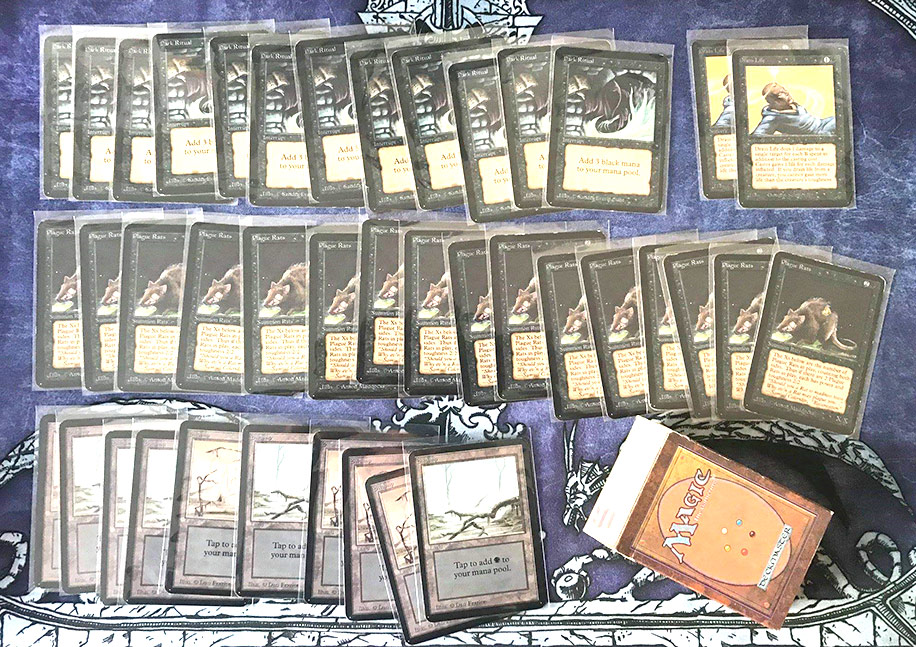
The other “pure” obvious and feasible deck to build is the Bolt deck. The deck with just Lightning Bolts and Mountains may sound boring, but it’s a force. To beat it, you need not only a clock, but you need an offense or a way to win the game that can’t simply be destroyed with Bolts. That rules out Channel Fireball, Juggernauts, and basically any common creature offense. It certainly rules out plodding paths to victory like curses.
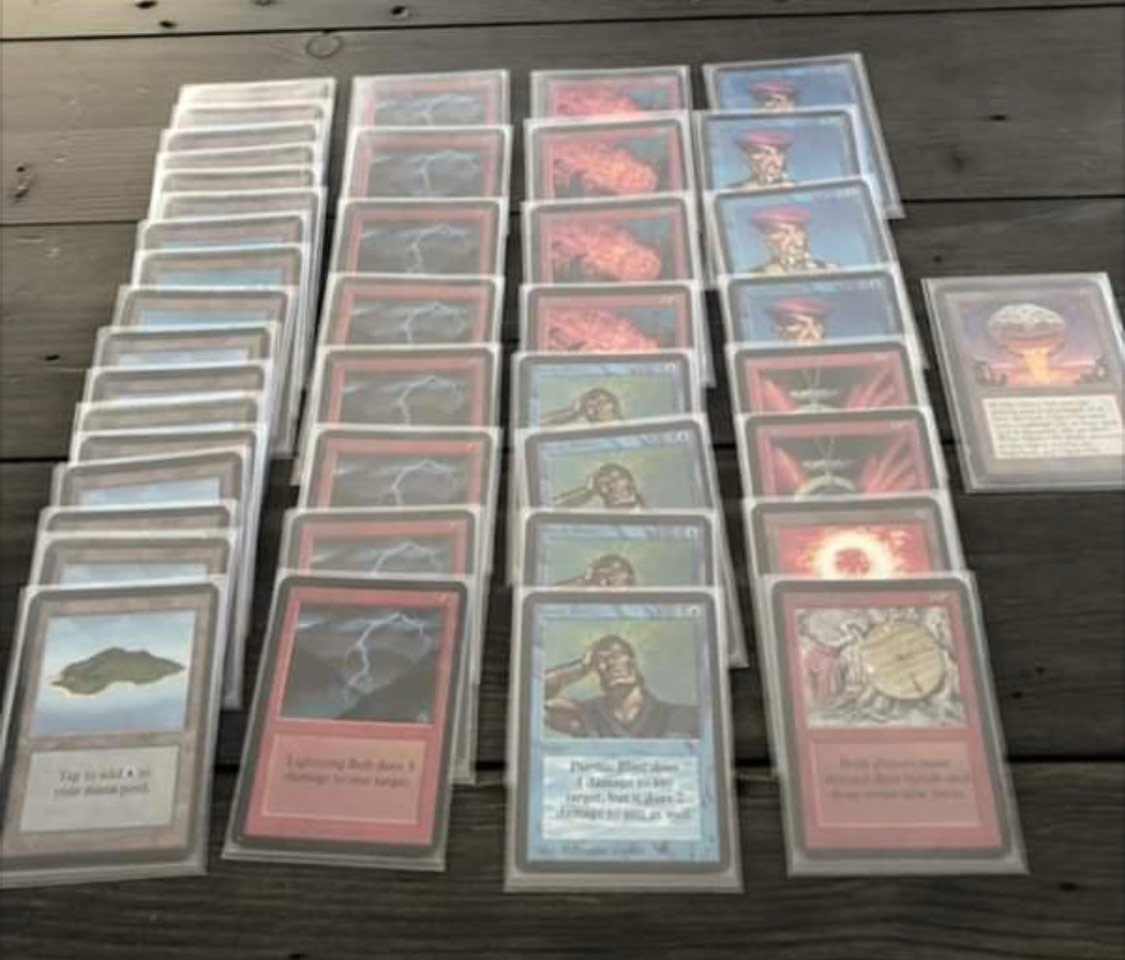
The Bolt deck is a force to behold in Alpha 40, even if it’s not all Bolts.
Despite these metagame poles, most decks are not going to be constructed one or two simple dimensions. Most decks, by practical necessity if anything else, are going to be a mixture of the above approaches.
Deck Building in Alpha 40
Acquiring basic resources – even land – in Alpha 40 is no small thing. But the locus of the format, outside of Power 9, is Sol Ring. There are few strategies or concepts that aren’t improved by Sol Ring, and it is (relatively) affordable, as a major deck building component.
Therefore, in terms of deck construction, I began my engagement in the format with a hunt for Sol Rings. I set a target of 4 Sol Rings, which seemed reasonable, and not excessive. Fortunately, I was able to acquire three rather quickly for under $400 each, and picked up the fourth one at the same cost with some luck at GP Oakland at the beginning of the year.
From there, I felt I could build basically anything my card pool permitted. I had Serra Angels, Sengir Vampires, Juggernauts, and Jade Statues. Sol Ring fueled all these goodies.
But Alpha 40 is more than an exercise is rote deck optimization and deck possibilities. It’s also about the experience you want to curate.
It goes without saying that the most powerful deck you can build in Alpha involves most or all Power Nine, such as Black Lotuses, Moxen, and draw spells like Ancestral Recall and/or Timetwister. But on a “budget,” what kind of deck might I build?
I decided that Channel-Fireball was likely the most powerful game-winning combo in Alpha. There are lots of “one-card” combos, like Mind Twist and Balance, but without tons of acceleration or artifact mana, they aren’t reliable. Channel, however, can do more than cast lethal burn spells. As I owned 3 Alpha Jade Statues and 4 Juggernauts already, Channel seemed quite attractive. You could burn your opponent out, or you could deploy 2-3 four mana artifacts on the first turn. It’s not Channel into Emrakul, the Aeons Torn, but it seems difficult for an opponent to overcome a trio of four-mana artifacts on the first or second turn.
At Eternal Weekend North American 2018, I was able to give my deck a test run. In between rounds of the off-site Old School event, hosted by Eternal Central, I was able to play pickup games of Alpha 40 against Bog Agra and Shane Semmens. Those games proved my assumption correct: early Channel into multiple Juggernauts was difficult to beat, and I also just won games with Channel-Fireball.
Building a deck was not easy, but tuning it would be even more difficult.
Channel-Fireball
Alpha 40 introduces a possibility that is almost unheard of in constructed Magic: the ability to play more than 4 Channel, let alone more than 1. This raises an interesting question: what is the optimal number of Channel?
You want to find Channel reliably, but multiple Channels are horrendous. The second Channel has almost no marginal utility. You can only pool most of your life once. This was not the kind of question that you can easily resort to conventional Magic math to answer. Rather, it is best answered by playing some games and testing the numbers.
In the end, I concluded that 5-6 Channels is probably the optimal number for a 40 card deck. 6 or 7 might be correct if you are playing a pure combo list, with no other tactics besides burn. But 5 or 6 is better if the overall quality of the rest of your cards matter.
You want more burn spells than Channels, so my basic rule of thumb is that your quantity of burn spells should be at least greater than the number of Channels. In the end, I landed on 5 Channel and 6 Fireball. But another Fireball, especially with Sol Rings, is entirely defensible. In fact, it’s hard to find a true ceiling on the number of Fireballs you could want. It could be as many as 9 or 10. They can pick off defenders or finish an opponent off.
Fine Tuning
As noted above, I owned 4 Juggernaut and 3 Jade Statue. Imagine my surprise that with only a bare minimum of testing, Jade Statue proved generally superior to Juggernaut. Consider the decks I just described. What would you rather have against basically any of them? Jade Statute is better against all four of the archetypes mentioned: The Bolt deck, the Hero deck, the Rat deck, and the Sprite deck.
Aside from just pure speed, Jade Statue is basically superior in every other way. It’s even better against Balance.
Because my deck has 4 Juggernaut and 3 Jade Statue, I wanted to include a pair of Icy Manipulators as mana disruption and blocker disruption. At Pat Chapin’s suggestion, I tested Ice Storms but they were basically inferior to Icy.
That led me to this deck:
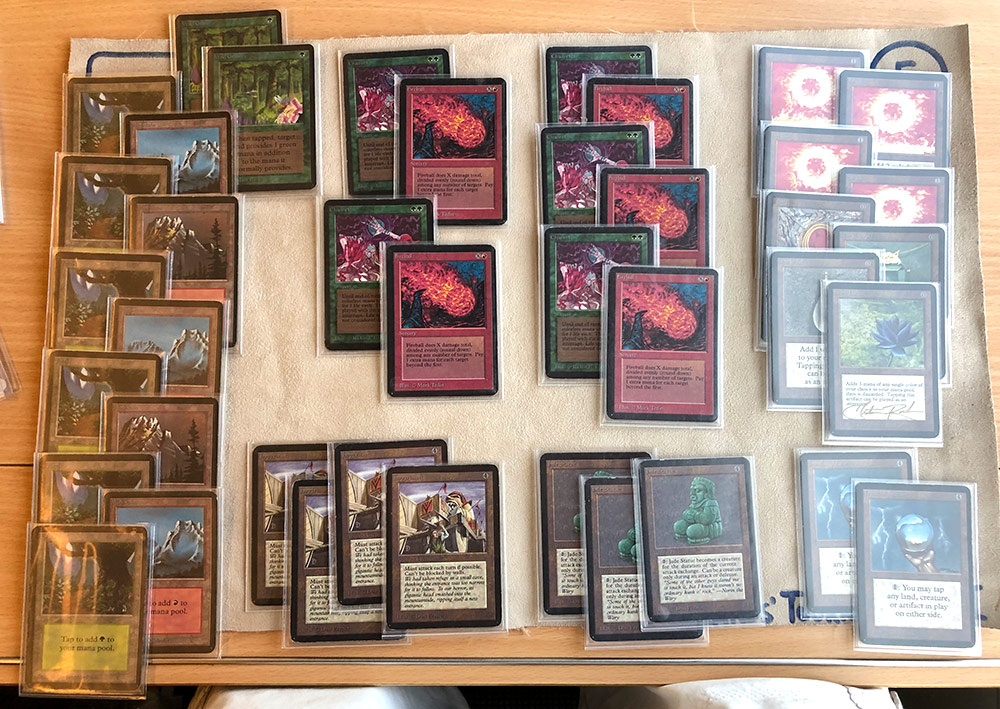
The most important card beyond the combo is Black Lotus. Lotus enables the fastest kill by famously providing the mana for Channel, and the additional green needed for the 20th point of damage.
I was quite pleased to pick up an Alpha Lotus in the fall of 2018, but my quest for a second one fell short. I haggled with dealers at Eternal Weekend, but couldn’t quite pull it off. After Eternal Weekend, I basically gave up. But I figured there might be a chance I could borrow a 2nd one. I would cut the single Wild Growth for a 2nd Lotus, if I could find one.
The Wizards Tournament Rules
The first Wizards tournament, mentioned above, was organized to coincide with n00bcon 10 in 2018. In order to preserve the spirit of playing under “First Edition” rules, the tournament organizers allowed cards basically to work as their templating suggests. Since Alpha cards were anachronistically templated, this creates some strange interactions including, most problematically, the ambiguity in the use of the word “discard.” Unfortunately, some Alpha cards use the word “discard” to refer to destruction from play, as well as from hand. Therefore, the Wizards Tournament judge – called a “referee,” permitted Disrupting Scepter to operate as a one-sided Smokestack with every activation once the opponent’s hand was wiped out.
Fortunately, this interpretation was corrected for the Wizards Tournament II. For this event, 10 specific card errata were issued, as you can read here, along with the full tournament description. The main oddity remaining is that Balance does not kill Black Knight, since it is “immune” to white Magic, according to the FAQ.
But there was a crucial ambiguity: how did Chaos Orb work? The short answer: the referee decides. On the day of the event, I approached the referees in search of clarity, simply for my own edification. After all, if the tournament were officiated under actual First Edition rules, then card template controls. That suggested, by inference, that players could basically move cards at any point.
My main concern was that, for fear of Chaos Orb, I didn’t want to have to spread my cards out all over the table to avoid the risk of getting 2-for-1ed (or worse) by Orb. The referee confirmed that players could move cards at any time so long as they didn’t interfere with the Orb flip. This answer left some interesting possibilities, but I resolved not to test them, as it really wasn’t that serious.
The Blue Vise
The trip to Europe was incredible. I was traveling with the legendary Brian Weissman and Daniel Chang. We all took the same flights out of San Francisco and could pool travel costs (I was not representing or sponsored by Daniel’s business – it’s been many years since I’ve done that). We made a trip out of it, starting in Zurich, going through the Alps, then through Hamburg, and into Demark and Sweden, spending two nights in Stockholm after the Magic tournaments in Gothenburg. Daniel had agreed, before the event, to loan me a second Black Lotus, and had built Brian a sweet Black and Red control deck with a ridiculous amount of Chaos Orbs.
I discovered, however, that Daniel had constructed an absolutely absurd creation, which I dubbed “The Blue Vise.” It was basically Mox Sapphires, Black Lotuses, Ancestral Recalls, a few Timetwisters, and about a half dozen Black Vises. At some point during the trip, I expressed interest in playing Daniel’s deck, and told him that he would really enjoy playing mine.
Although I had enjoyed the process of building and playing my deck, I felt I could improve Daniel’s deck even more, and would more fully appreciate the historical significance and momentous occasion of playing the Blue Vise.
We deconstructed the Blue Vise deck, and the main change I made was to begin cutting Vises and adding more Ancestrals and more Mox Sapphires. I loaned some of my own cards which I wasn’t using to the endeavor, thus making a few of the cards in Daniel’s Blue Vise deck my own. I tinkered with the ratios a bit more, and concluded that the deck really only needed 2 Black Vise: in case one was exiled through fake ante.
Here’s what I ended up playing:
Humbled to be able to play this today at the Wizards tournament. All of my opponents have been great sports. @mgdelaval was able to thwart a first turn Victory by playing Twiddle on both Vises! pic.twitter.com/msG7mQbjOl
— Stephen Menendian (@SMenendian) April 18, 2019
With 2 Black Vises in play, you basically need to cast 3 Ancestrals on your opponent to win the game. The target is 14 cards in hand, with both Vises, to inflict 20 damage. That means you need three Ancestrals to get a 7 card hand above 14 cards.
The deck plays a pretty straightforward game plan:
1) Cast Mox Sapphires into Ancestral Recalls to draw more Sapphires and Ancestrals.
2) Once you have basically drawn most of your deck, play all or most of your permanents.
3) Then cast Timetwister to reset the game. The purpose of this is to refill an opponent’s hand to 7 if they have played any cards, or to put you out of any danger of decking and give you position of basically unbeatable strength if anything should go awry. You can just reset the game the next turn if need be.
4) Ancestral Recall your opponent three times and pass the turn with both Vises in play.
In retrospect, I think the deck only wants three Timetwisters (two in case one is anted, and a redundant one so you can recur the first), but otherwise, it was a perfect deck.
The Best Deck Ever?
In fact, there was one big revelation I had during the process of tuning the Blue Vise. In my History of Vintage: 1993 chapter, borrowing from Steven Merritt, I had assumed that “BrainTwist” (30 Black Lotus, 29 Timetwister, and 1 Braingeyser, which I felt was superior to Fireball) was the best deck ever conceived.
I must revise that opinion.
The test for whether a deck is the best deck ever is not simply its ability to win on the first turn of the game through disruption. It is consistency.
The problem with any deck that is basically X Lotus and X Twisters is that that deck will, by necessity, be less consistent than one whose core is actually Ancestral Recalls and Black Lotuses. The reason is simple: the BrainTwist deck has more mana, and therefore has a higher probability of drawing an all Lotus (or all mana) hand.
The Blue Vise deck only has 15 mana sources: 11 Mox Sapphire, 4 Black Lotus, and a land. Thus, it has less of a chance of drawing an all land hand than the theoretically modeled Lotus/Twister deck. There has been some great mathematical modeling of these decks using computer technology, and the results are quite interesting.
In any case, Timo Konen figured out that the optimal BrainTwist deck has 19 Black Lotus, 11 Braingeyser, and 10 Timewister. The higher mana count means, I think, a greater chance of stalling by getting an all Lotus hand.
In contrast, the Blue Vise has a smaller mana base, but only needs one Sapphire to get the ball rolling. I hope Timo investigates this, but my assumption is that Ancestral Recall is actually the best variance reducer in the game, not Timetwister, unless, of course, all of your mana is from Black Lotus. Even then, I’m not sure that Twister is superior to Ancestral.
Put another way, any Alpha deck with, say, 15 Mox Sapphire/Black Lotus and 15 Ancestral Recall, is probably a better variance reducer than a deck with anything else, even just Black Lotus and Timetwisters. That’s because the latter requires more Lotuses than the deck whose spine is Ancestral.
All of this is a longwinded way of saying that, at this time, my assumption is that I was playing very likely the best deck ever constructed for tournament play. Almost certainly this was true for just all Alpha cards, as there was only a 7 week period between the release of Alpha and Beta, and it is extremely unlikely that any player was able to build and tune – with the rudimentary understand of the game that existed at the time – a deck anywhere near this level of power and consistency.
And secondly, it is likely, although less certain, that no one has even built a deck of this power with any other mix of cards. That means that I was playing likely the best deck ever built, and almost certainly the most broken using all Alpha.
Why would I play this monster in this laid-back event? As a historian of Vintage, and an avid enthusiast of the early game, how could I not? It was a once-in-lifetime opportunity to be the most powerful Wizards to ever play a game of Magic. Or, as another writer dubbed me, Stephen the Sorcerer.
I expected that most of my opponents would be good sports. I imagined that a few would be awed or truly impressed at the deck, a few would tolerate, and perhaps even enjoy the spectacle, but that at least some would be non-plussed, and perhaps even irritated. To mitigate this, I resolved to buy all of my (Swiss round) opponents a drink at the bar, to allow all of my opponents to play first, and – above all – to apologize in advance.
The Tournament
To my surprise, all of my opponents were good sports (at least outwardly), and none were visibly upset with me or at my deck. In fact, a number of them, including Lord Magnus, seemed genuinely affected, even awed, by the power of the weapon I wielded. Every one of my opponents was happy to share their decks with me after seeing mine explode onto the table.
My most profuse apologies were reserved for my first opponent, an incredibly nice young man named Peter, who was playing a mono-green aggro deck. He played a first turn Scryb Sprites, and then was slaughtered on the first turn. A similar pattern unfolded in the second game. I took him to the bar, bought him a mug of whatever beer was on tap, and we wandered around the room to soak in what was very likely the largest concentration of Alpha cards since Magic first rolled out of the Carta Mundi factory back then, or the game’s debut at Origins 1993, or the first World Championship at GenCon 1993. No one else had yet completed their match.
In the second round, I played one of the twin brothers playing a deck I cannot recall, but I recall was pretty.
In Round 3 I played Magnus, the tournament organizer, who was playing a 70+ card Blue-Black deck with Time Vault, and four Twiddle. His deck was the only deck that was able to thwart a Turn 1 victory by playing a first turn Black Lotus, and using two Twiddles to tap my Black Vises. Unfortunately, I reset the game on turn 2, and he didn’t have a Lotus or pair of Twiddles.
In round 4, I played Everitt, whose name I could not pronounce to save my life, and who also proudly showed me his Ice Age constructed deck, which was also mono-green.
As the tournament progressed, paradoxically, my anxiety rose. Not because I feared defeat, but because my deck was so overwhelmingly powerful that a game loss would be humiliating. My nerves centered less on what my opponent’s deck was, than whether someone might Mind Twist or Balance my hand away on the first turn.
But this was just a case of nerves, not well-founded worries. I won every game I played on Turn 1 the entire day (meaning, they died in their upkeep), except for the game where Magnus Twiddled both of my Vises.
Round 5 I played a red-green deck piloted by the other twin brother.
Round 6 I played against a Bolt heavy deck (the lowest life total I ever fell to in the tournament was 14 – a first turn Bolt followed by a Bolt in the upkeep of my opponent’s second turn).
The tournament was only supposed to be 6 rounds, but a Finnish player approached me and requested a match. I warned him, but he insisted.
I led with Mox Sapphire and Ancestral, and then another Sapphire and Ancestral, and my opponent comically observed that I was quite lucky. But then when I played another Sapphire and Ancestral, the jig was up. He had a cool deck with like 4 Serra Angels, but never got to cast them. I ended the Swiss rounds with 7 wins in a 6 round tournament.
Brian Weissman also ended up undefeated, but there were two additional players who were 5-1. The referee decided this would be the Top 4, even though the other two players had not finished their last round.
In the Top 4, I played against the guy who lost to Richard Stebbo. He played Ancestral Recall on turn 1 both games against me, but I killed him on my Turn 1 each game.
On the other side of the bracket was an absolutely epic match with Brian Weissman against Stebbo. In the decisive game, Brian had to fake ante one of his two Fireballs (which effectively exiles them for the game). He had a Juggernaut pecking away at Stebbo, and Chaos Orbed Stebbo’s key colored mana sources (Brian’s deck had like 7+ Chaos Orbs). Brian sent Stebbo to 9 when Stebbo found a Jayemdae Tome that Brian could do nothing about. From there, he found a Balance, and killed the Juggernaut, leaving Brian with no more win conditions. Brian played a suicidal Wheel of Fortune, decking himself.
My match against Brother (of the Fire) Stebbo was anticlimactic. I won the die roll (the only match in which I played first the entire day), and played first. I won on turn 1. And Stebbo declined to play a second game, and therefore scooped.
This left me as the victor of the tournament, and I won this incredible necklace trophy:
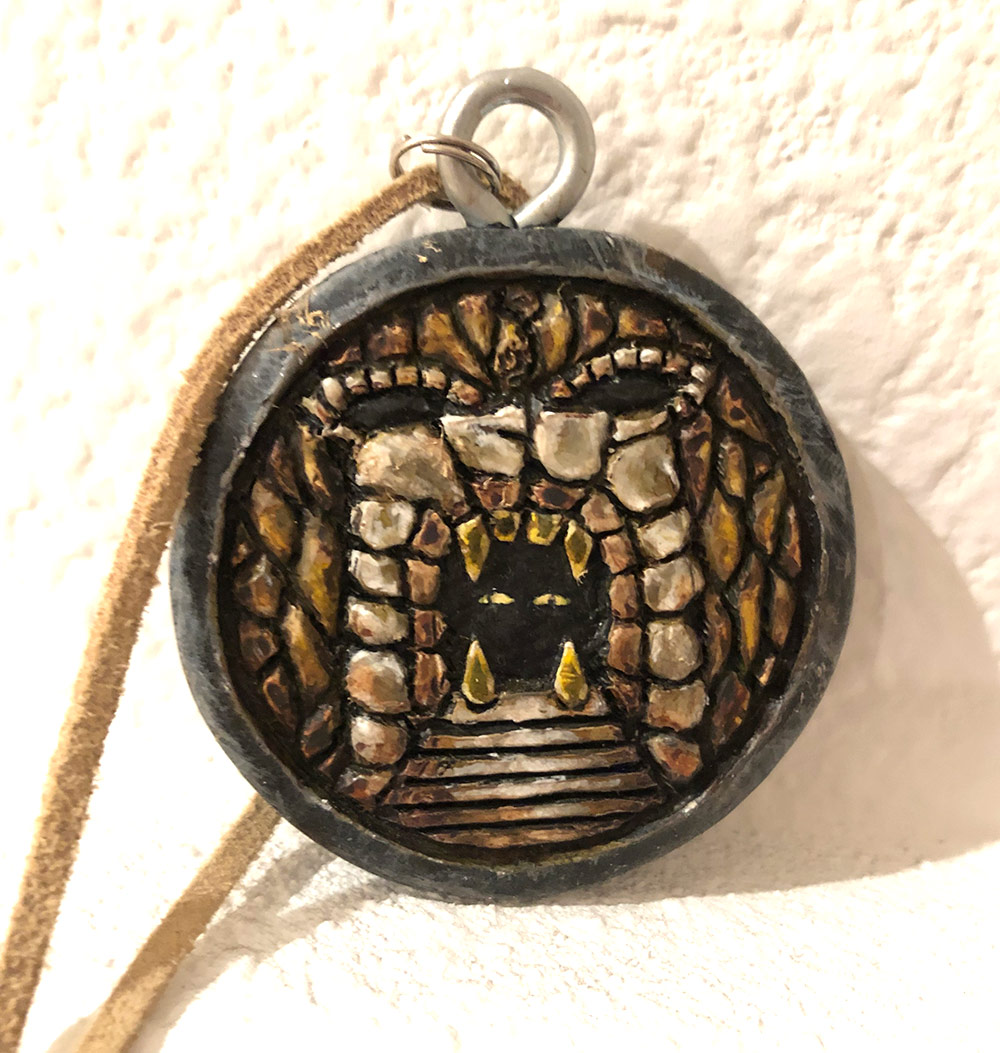
As beautifully handcrafted as it is, this Howling Mine pendant will not be drawing me any extra cards. I will, however, be wearing it at all Old School tournaments in the near future.
Daniel had a blast playing my Channel-Fireball deck. He said it felt like gambling, and he ended up 4-2.
I’m pretty sure I would have ended up in the top 4 with my Channel deck, but I couldn’t pass up the once-in-a-lifetime opportunity to be the most powerful Wizard ever. I wouldn’t play the Blue Vise again, but I’m glad I was able to do it once. I even gained some insight into the theoretical possibilities of the game that I otherwise would likely never have realized.
As a coda, upon entering the pub, Magnus was selling copies of a small, black and white magazine called “The Prodigal Sorcerer” for just 20 sek (a couple of bucks). This was a magazine that had a print run of just 120 copies, and the inside cover included a request not to reprint or republish any portions, so I will refrain from doing so. But I have to complement Magnus and Svante or their excellent articles. The article on “Wards,” which apes an article on Circles of Protection in the first issue of the Duelist, was fantastic. Similarly, it also contained a recap of the Wizards Tournament I, and an article on curses.
The next day, when I asked folks if they had read the magazine yet, they said that they ‘didn’t have time.’ When an issue of the Duelist came in the mail back in 1994, I read it front to back regardless of whether I had time. I was up until 3am the night before n00bcon reading the magazine, which is a treasure.
I had a blast playing Alpha 40, and I’m going to continue to enjoy Alpha 40 for some time to come. If you ever want to play with me, let me know, and I’ll be happy to oblige.
Until next time,
Stephen “The Sorcerer” Menendian

